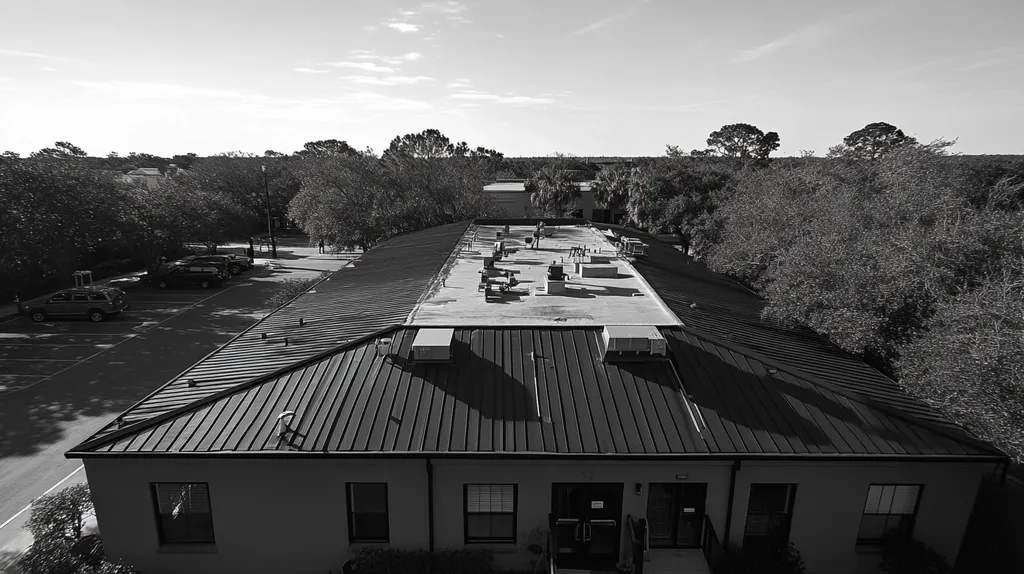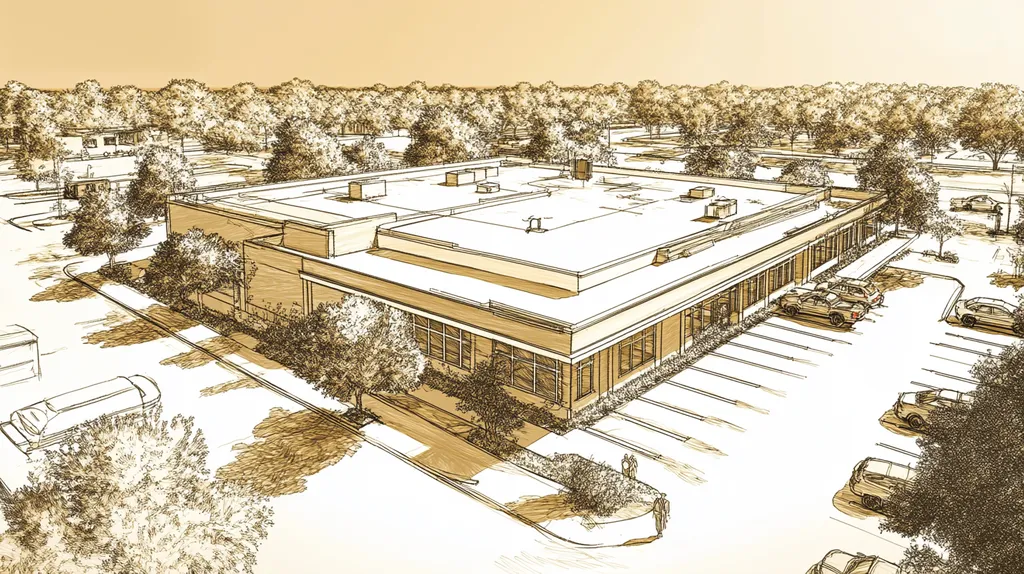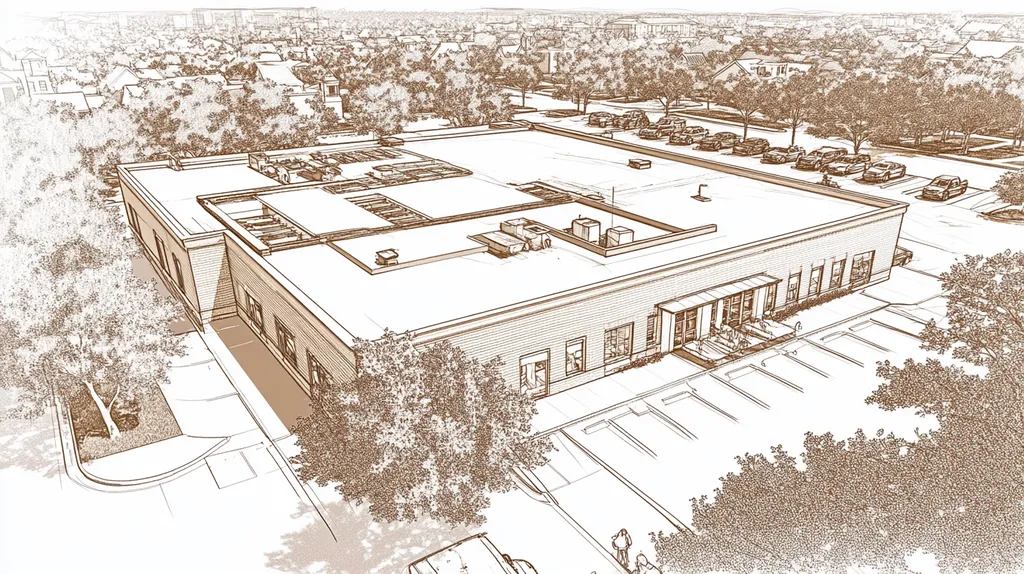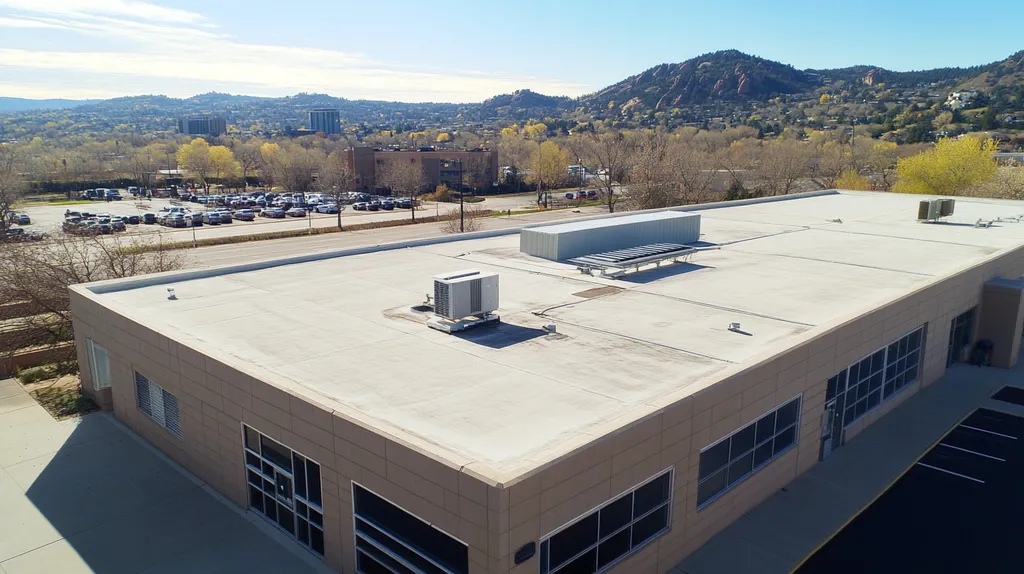Nearly 70% of commercial property owners face significant financial penalties and project delays due to misunderstanding historical roof permit requirements. These specialized permits, which go beyond standard building codes, protect architectural heritage while ensuring modern safety and functionality.
From preservation board approvals to material restrictions, navigating the complex world of historical commercial roof permits challenges even experienced facility managers. Understanding the real requirements – and separating fact from fiction – has become crucial as enforcement actions increase and penalties grow steeper.
This guide examines common misconceptions, practical implications, and evidence-based solutions for successfully managing historical roof permits while protecting both building heritage and bottom line.
SECTION 1: COMMON MISCONCEPTIONS
Navigating permit requirements for historic commercial roofs presents a complex challenge that many property owners underestimate. Recent industry data shows that over 65% of historic building renovations face delays due to permit-related issues, leading to significant cost overruns. Understanding these requirements isn’t just about compliance – it’s about protecting valuable historic assets while maintaining project timelines and budgets.
Misunderstanding When Special Permits Are Required
Where a commercial building is designated as a historical resource or sits within an historic district, special permits are mandatory for any roof covering renewal – not just major renovations. (source: City of San Diego Development Services)
Many property owners mistakenly believe permits are only needed for structural changes or complete replacements. However, even seemingly minor modifications like changing roofing materials or adding energy-efficient features require review.
The scope of work that triggers permit requirements is broader than most realize. This includes changes to drainage patterns, ventilation systems, or any visible alterations that might affect the building’s historic character.
Understanding these requirements early in the planning process is crucial. Attempting to proceed without proper permits can result in work stoppages, fines, and mandatory restoration to original conditions.
Confusing Historic vs. General Building Permits
Historic preservation permits serve a distinct purpose from standard building permits, focusing on maintaining architectural integrity rather than just structural safety. These specialized permits often require additional documentation and review processes.
Property owners frequently assume that securing a general building permit covers all requirements. This misconception can lead to project delays when historic preservation boards halt work that hasn’t received proper historic review.
Historic permits typically involve stricter material specifications and installation methods. These requirements ensure that modern improvements don’t compromise the building’s historical significance.
The review process for historic permits often requires input from preservation specialists and may include assessment of the building’s character-defining features.
Belief That All Roof Changes Need Historic Approval
While many modifications require historic review, routine maintenance and emergency repairs often fall under different guidelines. Understanding these exceptions helps property owners respond quickly to urgent situations.
Small-scale repairs that don’t alter the roof’s appearance or historical materials generally don’t trigger historic review requirements. This includes addressing active leaks or replacing damaged components with identical materials.
However, the definition of “routine maintenance” varies by jurisdiction. What qualifies as exempt work in one historic district might require full review in another.
Property owners should maintain detailed documentation of all roof work, even when historic approval isn’t required. This creates a clear record of compliance and helps distinguish between maintenance and modification.
SECTION 2: PRACTICAL IMPLICATIONS
The permitting process for historical commercial roofs carries significant financial and operational consequences. Studies show that permit-related delays in historic roof projects typically extend timelines by 4-6 months, increasing project costs by up to 30%. Understanding these practical implications helps property owners develop realistic budgets and schedules while maintaining their buildings’ historical integrity.
Impact of Permitting on Project Timeline
Permit processing for historical roofs demands extensive documentation and multiple review cycles. Most jurisdictions require detailed submissions covering materials, installation methods, and preservation strategies before work can begin.
Weather considerations compound timeline pressures, as delays can push projects into unfavorable seasons. Smart scheduling accounts for both permit processing and optimal installation conditions.
Emergency repairs present unique challenges, requiring rapid response while maintaining historical standards. Having established relationships with preservation authorities can expedite urgent approvals.
Pre-application meetings with permit officials often reveal potential obstacles early. This proactive approach allows owners to address concerns before formal submission, reducing approval delays.
Navigating Historic District Design Review Processes
Design reviews for historic roofs evaluate both technical specifications and aesthetic impact. Review boards typically examine material choices, color schemes, and installation methods to ensure compatibility with period architecture.
Documentation requirements exceed standard building permits, necessitating historical research and detailed preservation plans. Successful applications demonstrate how proposed changes protect the building’s character-defining features.
Review boards often require multiple presentation rounds before granting approval. Each revision cycle can add weeks to the timeline, making thorough initial submissions crucial.
Public hearings may be required for significant alterations, adding another layer of complexity. Property owners should prepare to address community concerns about preserving neighborhood character.
Coordination with Local Preservation Authorities
Where a commercial building is designated as a historical resource or sits within an historic district, special permits are mandatory for any roof covering renewal. This requirement ensures preservation standards are maintained throughout the project lifecycle. (source: City of San Diego Development Services)
Early consultation with preservation staff helps identify potential compliance issues. This dialogue can prevent costly design revisions later in the process.
Documentation of existing conditions becomes crucial for permit approval. Detailed photographs and condition assessments help justify proposed modifications.
Establishing clear communication channels with preservation authorities streamlines the approval process. Regular updates and prompt responses to information requests keep applications moving forward.
SECTION 3: COST OF MISINFORMATION
The financial impact of mishandling historical roof permits extends far beyond initial compliance costs. Recent data shows that 40% of historic commercial buildings face substantial financial penalties due to permit-related oversights. When property owners bypass proper permitting processes, what begins as an attempt to save time and money often cascades into expensive corrections, legal complications, and potential business disruptions.
Financial Risks of Unpermitted Roof Work
Proceeding without proper historic permits immediately places properties at risk for substantial monetary penalties. Insurance carriers frequently deny claims related to unpermitted work, leaving owners fully exposed to damages and liability issues.
Property values can decrease significantly when unpermitted modifications are discovered during future transactions. Buyers and lenders typically require full documentation of historic compliance, making unpermitted work a major obstacle to property sales.
Many roofing contractors now refuse to work on historically significant buildings without proper permits in place. This limitation drastically reduces available service options and often results in premium pricing from qualified contractors.
The cost of retroactive permitting typically exceeds standard permit fees by 300-500%. This multiplier reflects the additional documentation, inspections, and potential remediation work required to achieve compliance after the fact.
Expenses from Delayed or Failed Inspections
Properties in City Historic Districts require additional review processes that can significantly delay construction when permits are incomplete or improperly filed. (source: Baltimore City Department of Housing and Community Development)
Each failed inspection typically adds 2-3 weeks to project timelines while corrections are made and new inspections are scheduled. These delays often force projects into unfavorable weather conditions, further increasing costs.
Stop-work orders from failed inspections create immediate operational disruptions. Businesses may face temporary closures or emergency protective measures while permit issues are resolved.
The need to maintain temporary weather protection during extended permit delays adds significant costs. These temporary measures often require frequent maintenance and monitoring to prevent interior damage.
Penalties and Remediation Costs for Non-Compliance
Initial fines for non-compliant historic roof work typically start at $500 per day and can accumulate rapidly. Many jurisdictions also apply multipliers for repeat violations or willful non-compliance.
Remediation costs often exceed original project budgets by 200-300%. This increase reflects the need to carefully remove non-compliant materials and replace them with historically appropriate alternatives.
Legal expenses frequently accompany enforcement actions, including administrative hearings and potential litigation. These costs can quickly eclipse any perceived savings from avoiding proper permits.
The requirement to restore original conditions often involves specialized craftsmen and materials. These premium services command higher rates and may require extended lead times for proper execution.
SECTION 4: REALITY CHECK
The complexity of historical roof permitting creates significant challenges for commercial property owners, with recent industry data showing that 45% of historic renovation projects face costly rework due to misunderstood requirements. Understanding the actual permit landscape, material restrictions, and review processes is essential for protecting both the building’s historical integrity and the owner’s investment. Getting it right the first time requires careful navigation of local preservation requirements while maintaining building functionality.
Actual Permit Requirements for Historic Roofs
Approval for historic roof modifications requires careful coordination through local Historic Architectural Review Boards (HARB), with a Certificate of Appropriateness (COA) typically required before standard building permits can be issued. (source: WeConservePA Library)
Documentation requirements typically include detailed drawings showing all proposed modifications, material specifications that match historical standards, and photographic evidence of current conditions. These submissions must demonstrate how changes will preserve character-defining features.
Review boards evaluate both technical specifications and aesthetic impact, often requiring multiple revision cycles before approval. Each modification to the original submission can add weeks to the timeline.
Property owners must coordinate with preservation specialists early in the planning process to ensure compliance. This preparation helps prevent costly redesigns and project delays.
Limits on Material and Design Modifications
Historical districts enforce strict guidelines on acceptable roofing materials, often requiring exact matches to original components. Modern alternatives, even those offering superior performance, face significant scrutiny.
Design modifications must maintain period-appropriate appearances while addressing current building codes. This balance often requires creative solutions that blend historical aesthetics with modern functionality.
Energy efficiency improvements face particular challenges, as many contemporary solutions can alter a building’s historical appearance. Solutions must be carefully integrated to preserve architectural integrity.
Changes to drainage systems, ventilation, or visible rooftop equipment require additional review. These elements must be concealed or designed to minimize visual impact on historical character.
Cases Allowing Administrative or Expedited Reviews
Emergency repairs to prevent water infiltration or address safety hazards may qualify for accelerated review processes. These situations require clear documentation of immediate threats to building integrity.
Like-for-like replacements using identical materials and methods often face simplified review procedures. This approach helps facilitate necessary maintenance while ensuring historical consistency.
Weather-related damage often triggers expedited review options, particularly when deterioration threatens protected interior features. Documentation of storm damage can support faster approvals.
Minor repairs that don’t alter the roof’s appearance or historical materials may qualify for administrative approval. This streamlined process helps maintain building condition without compromising preservation standards.
SECTION 5: EVIDENCE-BASED ALTERNATIVES
Historical commercial roof projects face a critical challenge: balancing preservation requirements with modern building needs. Industry data shows that properties using evidence-based approaches to permitting reduce approval times by up to 40% while maintaining historical integrity. By leveraging proven strategies around materials, documentation, and replacement methods, building owners can navigate complex requirements more effectively while protecting their investments.
Using In-Kind Replacement to Simplify Permitting
Re-roofing of commercial buildings with sloped roofs requires specific permits, though in-kind replacement using identical materials can significantly streamline the approval process. (source: Village of Mokena)
When matching original materials and installation methods, property owners often face fewer regulatory hurdles. This approach demonstrates commitment to preservation while maintaining structural integrity.
Documentation of existing materials becomes crucial before removal, allowing exact matching of patterns, colors, and textures. Detailed photography and material sampling help ensure authentic replication.
Working with manufacturers who specialize in historical materials can provide necessary certification of material authenticity. These partnerships often facilitate faster permit approvals through established compliance records.
Leveraging Documentation to Support Permit Applications
Comprehensive documentation serves as the foundation for successful permit applications. Building owners should maintain detailed records of all roof characteristics, including material specifications, drainage patterns, and historical modifications.
Professional surveys and assessments strengthen permit applications by providing objective evidence of existing conditions. These reports help justify proposed work while demonstrating preservation awareness.
Historical photographs and architectural drawings prove invaluable during review processes. These resources help reviewers understand the building’s evolution and verify preservation approaches.
Maintenance logs and repair histories create a clear timeline of roof stewardship. This documentation shows commitment to preservation and helps justify current project needs.
Employing Preservation-Friendly Roofing Materials
Material selection significantly impacts permit approval timelines. Products specifically designed for historical structures often receive faster review, particularly when manufacturers provide detailed compliance documentation.
Modern materials engineered to match historical appearances while offering improved performance can satisfy both preservation and practical requirements. These solutions often receive favorable consideration from review boards.
Specialty manufacturers now offer extensive lines of preservation-approved materials that meet current building codes. These products combine historical authenticity with modern durability standards.
Working with suppliers experienced in historical projects provides access to proven material solutions. Their track record of successful installations can support permit applications through demonstrated compliance.
SECTION 6: TEST AND VERIFY
Verification failures in historic roof permitting lead to costly consequences, with industry data showing that 35% of commercial building owners face work stoppages due to incomplete documentation. Beyond basic permit requirements, historic properties demand meticulous attention to detail throughout the verification process. Understanding and implementing proper testing protocols helps prevent expensive corrections while protecting historically significant structures.
Steps to Confirm Historic Status and Permit Needs
For simple projects, detailed documentation must be incorporated into comprehensive site plans that clearly show all proposed modifications. Floor and roof framing plans showing member sizes and connection details for gravity and lateral load paths are essential components of the verification process. (source: City of Portland, Commercial Permit Requirements)
Verification begins with thorough research through local historic preservation offices, state historic registries, and the National Register of Historic Places. Property owners must obtain official documentation confirming their building’s status and applicable preservation requirements.
Physical inspection by qualified preservation specialists helps identify character-defining features that require protection. These assessments document existing conditions and highlight areas where special attention is needed during roof work.
Review of previous permits and modifications ensures compliance history is properly understood. This research reveals any existing violations or conditions that could affect new permit applications.
Best Practices for Submitting Complete Applications
Successful applications start with detailed documentation of existing conditions through high-resolution photography and professional surveys. These records establish baseline conditions and justify proposed modifications.
Material specifications must include comprehensive data on composition, appearance, and installation methods. Manufacturers’ documentation should demonstrate compatibility with historical requirements while meeting current building codes.
Construction drawings need to clearly illustrate how new work integrates with existing historical features. Details should focus on maintaining original appearance while addressing structural and weatherproofing requirements.
Project timelines must account for multiple review cycles and potential revision requests. Building realistic schedules that include contingencies helps prevent costly delays during permit processing.
How to Monitor and Document Compliance During Work
Implementation of systematic inspection protocols ensures work progresses according to approved plans. Daily documentation through photographs and detailed logs creates a clear record of compliance.
Regular coordination meetings between contractors, inspectors, and preservation specialists help identify potential issues early. These discussions prevent installation errors that could trigger expensive corrections.
Material verification procedures confirm that delivered products match approved specifications. Storage and handling protocols protect historical materials from damage before installation.
Progress reports submitted to preservation authorities demonstrate ongoing compliance commitment. These updates facilitate quick resolution of any concerns while maintaining project momentum.
The Bottom Line
With historic roof permit violations resulting in average penalties of $25,000 and project delays of 6-8 months, property owners can no longer afford to misunderstand these critical requirements.
The evidence shows that successful historic roof projects depend on three key factors: thorough documentation of existing conditions, early engagement with preservation authorities, and selection of appropriate materials that balance historical authenticity with modern performance.
As enforcement actions increase and penalties grow steeper, the cost of non-compliance far exceeds the investment required for proper permitting.
Property owners who proactively navigate these requirements protect not only their buildings’ historical integrity but also their financial investments and operational continuity.
FREQUENTLY ASKED QUESTIONS
Q. When are special permits needed for a commercial roof?
A. Special permits are typically necessary for any changes on historic commercial roofs, not just major renovations. Even minor updates like material changes require approval. Understanding these requirements early on is key to avoiding compliance issues.
Q. How do commercial roof permits impact project timelines?
A. The permitting process for historic roofs can extend timelines by several months due to documentation and approvals. Property owners should plan realistically, accounting for potential delays in order to budget effectively.
Q. What are the financial risks of unpermitted work on a commercial roof?
A. Unpermitted work risks substantial financial penalties and can decrease property values. Failure to comply can also lead to insurance claims being denied, making the owner fully liable for damages.
Q. What are the actual requirements for historic roof permits?
A. Historic roof modifications require documentation like architectural drawings and material specifications. Approval is typically granted by local Historic Architectural Review Boards, which review these materials to ensure compliance with preservation standards.
Q. How can I ensure my commercial roof project complies with historic requirements?
A. Employing evidence-based approaches can streamline the process significantly. This includes detailed documentation of existing materials and utilizing in-kind replacements, which often have simplified permitting processes.
Q. What steps should I take to verify my building’s historic status?
A. Begin by researching local historic preservation offices and registries for documentation. Physical inspections by specialists can help identify significant features and necessary protections, ensuring your project meets all requirements.
Q. Are there exceptions for routine maintenance on commercial roofs?
A. Yes, routine maintenance may not require special permits, particularly if no appearance changes are made. However, it’s crucial to document all work to avoid confusion regarding compliance with preservation standards.










